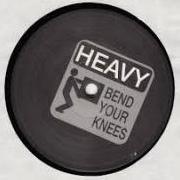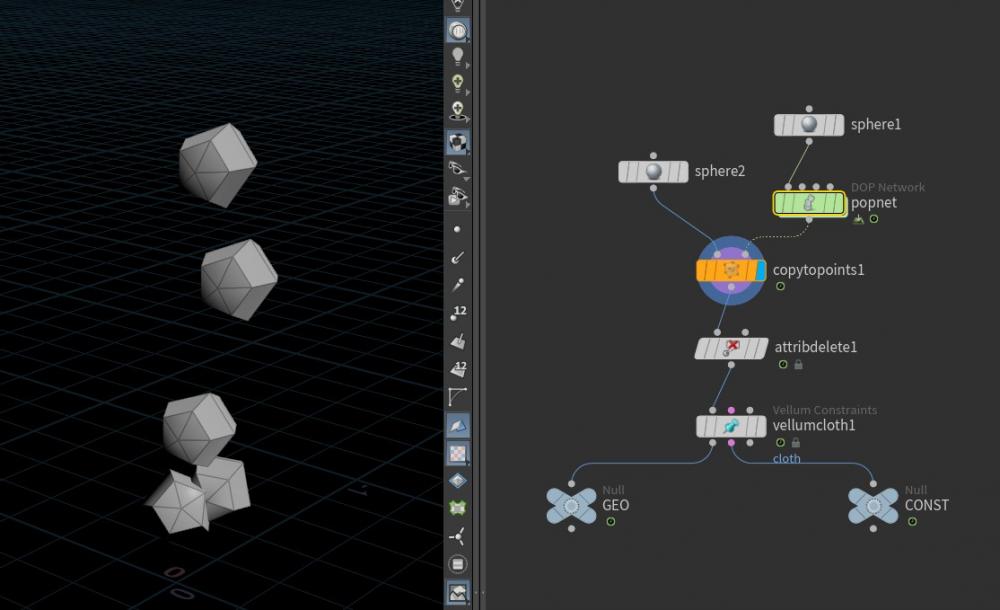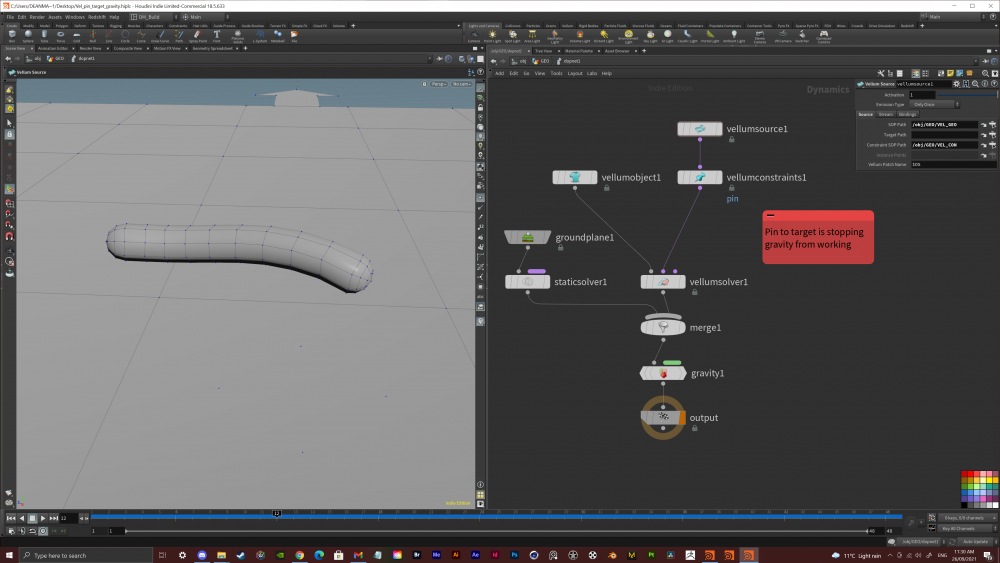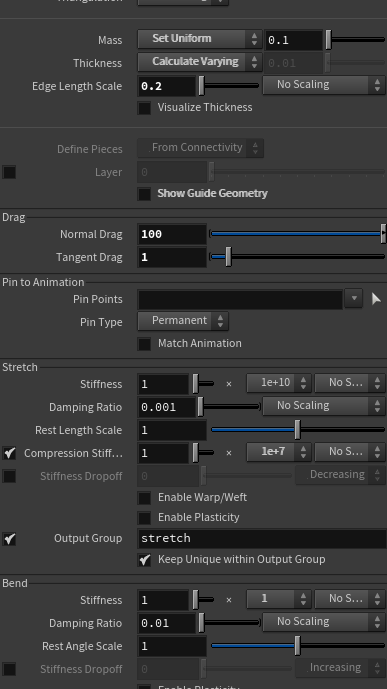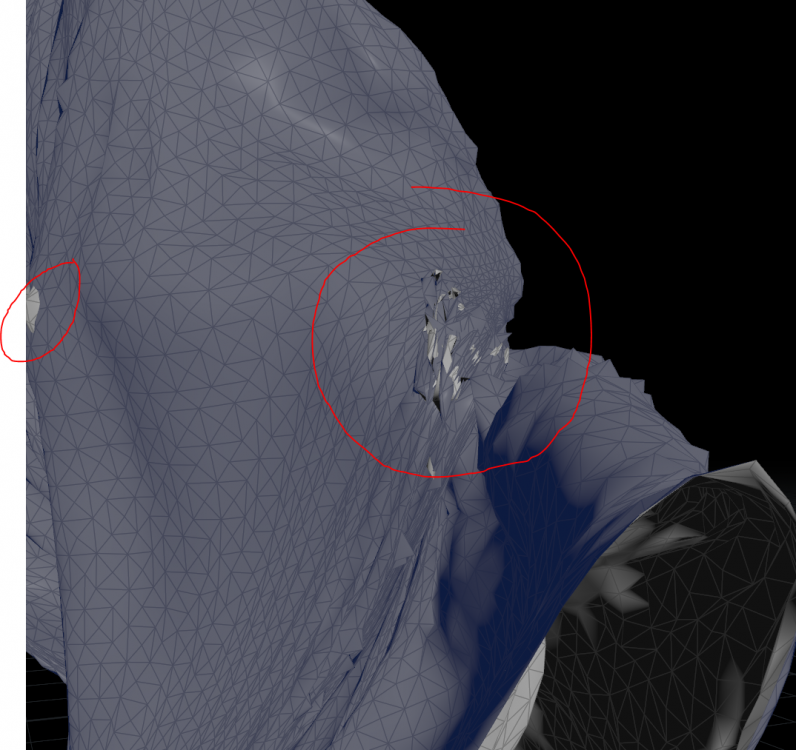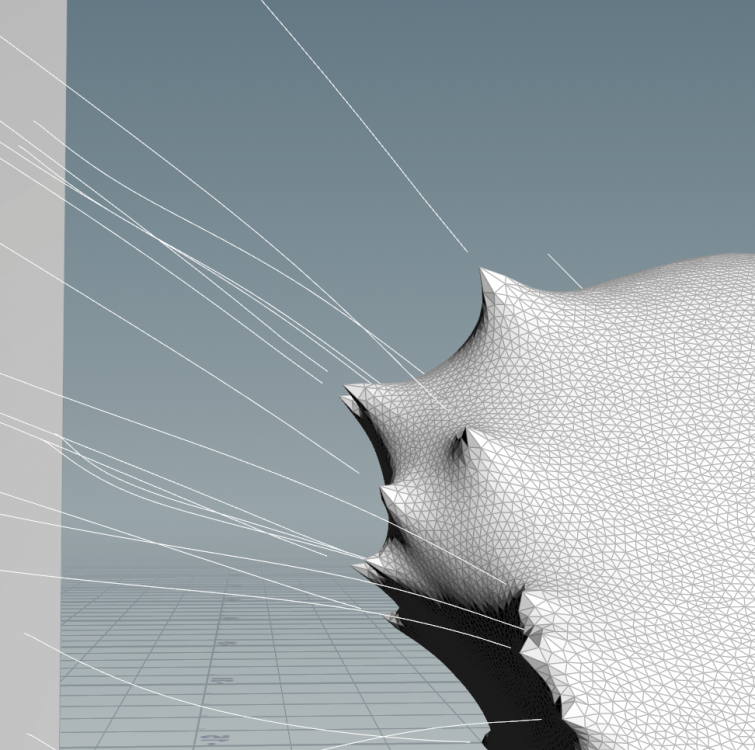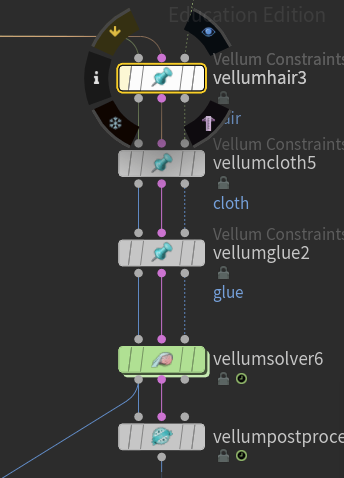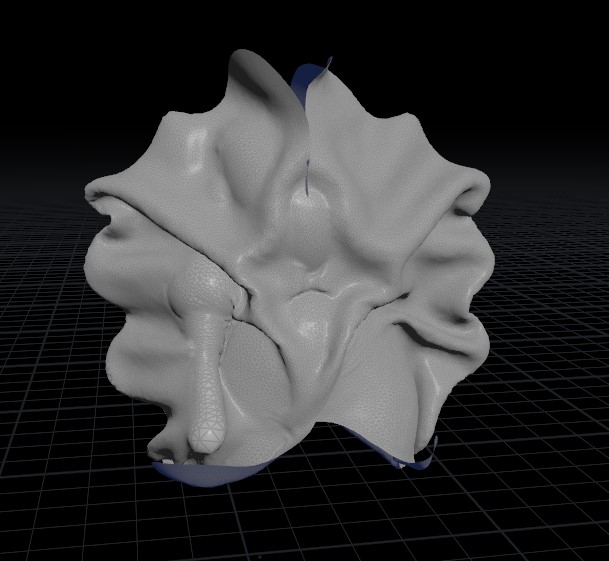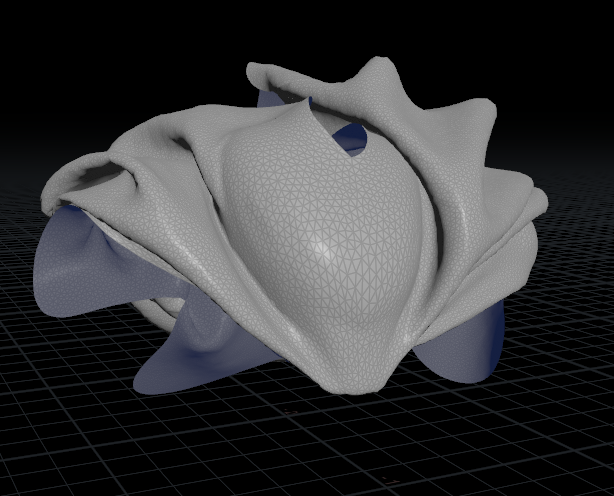Search the Community
Showing results for tags 'cloth'.
-
Dear Forumers, So I would like to make my vellum cloth higher resolution. I would like to do this AFTER configuration, welding and attaching etc. In my scene it would not be a MASSIVE mission just to upscale the point count on the initial geo and redo the other stuff, but I could see this being a huge problem if I had A LOT of attachments and welding. I would therefor like to know how I could up the point count on one of the cloths after the "fact". Thanks in advance for any help, .hip is attached =) Nick ASSASSINREALMSHOT01_024_FORODFORCE.hiplc
-
Hi all! I have a clothing simulation in an alembic by marvelous designer There are places in the simulation where the fabric is twitching or behaving strangely Are there tools that can change the alembic? Sculpture animation, for example... Guys help, I can't figure it out myself! Tell me what tools you can use!
- 1 reply
-
- simulation
- alembic
-
(and 4 more)
Tagged with:
-
Hi guys, I hope you can help me with setting up this vellum inflation scene... Basically, I have animated a sphere expanding and used the rest blend node inside the vellum solver to inflate the sphere. What I would like to achieve is an interaction where the vellum inflation sim interacts with a rigid body 'plinth' that it is initially sitting on rather than it just being a static collider object. I have tried using the vellum shape match constraint for this behaviour but have found it tends to deform the shape which is not ideal. Preferably, I would like to know if it is possible to use RBD dynamics inside of a DOP network and have that interact with the inflating vellum sim... The entire sim would also sit inside of a static container too as the plan is to squash the vellum soft body against the walls of the container. Any help on this would be really appreciated. Thanks! Vellum_Rigid_Body_Interaction.hiplc
- 1 reply
-
- rigid body
- cloth
-
(and 4 more)
Tagged with:
-
Houdini FFX Collection Get it here: Gumroad: https://davidtorno.gumroad.com/l/ffxcollection FFX Collection is a collection of scene builds and techniques for the intermediate users of Houdini. Those looking for quick setups, wanting to get more familiar with VEX use cases, and wanting to get started in Karma and Material X. This collection of “presets” as it were showcases a variety of topics within Houdini. Builds include FLIP, RBD, Vellum, POP, Pyro Solver, SOPs, LOPs, TOPs, Karma, and Material X. All renders use 100% fully procedurally generated textures created with Material X noises. The only exceptions are the test geometry textures which are directly read from their HDA embeded jpg textures. The HDA is a simple drop down list of all fifty builds, of which you choose the one you want and click “Build It” to have the tool generate the entire build for you. By default there is Network box organization to help understand the flow and processes that are occuring. Additionally there are annotated tips, and helpful explainer sticky notes to help inform an techniques used. These annotations are also optional and can be turned off before building the network. For those wanting to dive straight into everything there is to offer, there is a “Build All” button to create all 50 builds. This option will have each build turned off by default, so as to not overload your machine with too many items trying to cook. All builds involve various techniques and useful information. Each “category” is defined by the primary method used for the solution used. Be that by SOP nodes directly, VEX code, VOPs network, or even by simulation type like Vellum, Flip, RBD, or Pyro. Vellum does have a few builds under the VEX category as well. Builds include: FLIP Attraction To Curve Shape FLIP Fill Solid Object FLIP Melt Object FLIP Object Surface Advoidance ForEach Incriment Point Count Per Curve ForEach Poly Reduce Pieces By Volume Attrib ForEach Stacking Random Cubes PyroSolver Geometry Ripples PyroSolver Pyro Color Change Over Time PyroSolver Pyro Color From Texture RBD Activate Pieces RBD Apply Proxy Sim To HiRes Source RBD Attraction To Curve Shape RBD SOP Emit Every X Frames RBD V W Constrained Axis SOPs 8Bit SOPs Cull Random Curve Segments SOPs Dissolve Curve SOPs Dissolve Geo SOPs Echo Curve SOPs Post Shrink RBD Pieces Over Time SOPs Stone Path Vellum Animate Restscale Via Attrib Vellum Basic Fluid Cloth Two Way Coupling Vellum Cloth Flows Along Curve Vellum Define Cloth Ripping Vellum Flag In Wind Vellum Inject Geo Over Time Vellum Paper Whirlwind Vellum Spheres Expanding In Box VEX Blend Mask VEX Cull Back Faces VEX Custom Guides For Vellum Hairs VEX Falloff Radius Around Curve VEX Geo Look At Target VEX Geometry Ripples VEX Guided Infection VEX Per Poly Transform Via Particle Proximity VEX Per Prim Rotation Around Edge VEX Repeat Ramp Values VEX Ring Waves With Falloff VEX Rotating Grid Tiles VEX Sin Cos VEX Sliding Points Along Curve VEX Vellum Dangling Cables VEX Vellum Sim Forces From SOPs VEX Vellum Source Emission Instancing VEX Voronoi Fracture Animated VOP Blend Mask VOP Orientation Along Curve
-
Hey magicians, I'm trying to achieve a similar vellum sim like this, haven't installed H17 yet since I use Marvelous for cloth but this one will be hard on MD, any thoughts on how to approach this with vellum? Here's the reference: Thanks!
-
Hello Is is possible to add more and more geometries, on each frame, to a vellum (cloth) simulation? For example, simulating copied spheres on particles of a POP-Network sim, as a vellum cloth geometry source. (I know it's possible to update the "id" in an RBD sim to do the same effect.) Thanks for helping. Vellum_01.hip
-
Hello, I'm just getting into vellum and the solver seems fast and cool but I'm trying a sim here where the geometry tries to attach to its collision geo, but that ends up being very jittery at the end with what seems to be no loss of energy. I've uploaded a scene file. I've tried to set @v to zero at the end and that still hasn't worked. What're the steps to making this solver behave? vellum_basics__jitter_02.hip
- 11 replies
-
- vellum
- simulation
-
(and 2 more)
Tagged with:
-
Hey Everyone, I'm setting up a pretty basic vellum cloth simulation > a pop wind and a pop force as gravity only operating on one group and that group grows over time. now, when I let it run the solver seems to delete primitives as some kind of tearing effect (ripping apart the cloth under stress) I don't know. some primitives turn black and then they disappear. It's a kind of tearing effect that I want to avoid or disable, I just seem to not find the setting. I do have welds in the setup but breaking is disabled. I really don't want no tearing at all. It would be great if someone can push me in the right direction. Cheers captue_0002.mp4
- 1 reply
-
- vellumcloth
- vellum
-
(and 3 more)
Tagged with:
-
Does anyone have hints on how to achieve a similar effect as shown in this post by tyflow (an fx tool for 3DS max) : I'm so much in love with the effect, but I want to achieve it in Houdini! Thanks in advance for your wise advice! =)
-
- cloth
- simulation
- (and 5 more)
-
Helle there. I have a Sim from marvelous designer (Body and Cloth) and want to play around with vellum a bit. After importing/unpacking the alembic i separat it in two groups (cloth/body) and attach a vellum cloth node. The moment i attach it houdini always crashes so i guess it´s not the correct workflow... do i have to bring in body and cloth on my own and do the simulation/rigging in houdini? take care
-
Hey gang, I've run into a problem I can't get my head around. I have a Vellum cloth sim with a Pin to target constraint. I want the cloth sim to follow the target while also being effected by gravity and can't resolve making both the target cloth sim and gravity occur at the same time. Any insight would be MASSIVE help! Thanks. Hip is attached. Vel_pin_target_gravity.hiplc
-
- vellum
- simulation
-
(and 2 more)
Tagged with:
-
Hello everyone. I'm experimenting with vellum cloth. But the character has tremors in his arm. What could be the reason for this? Thank you for your help in advance. Subs 5 Cons Iterations 500 test_vellum.mov
-
Greetings! I'm trying to attach a vellum sim to a pop sim... The idea is that I first do a pop advection sim then attach vellum cloth to that so they collide and interact with each other... It's almost there, with one slight issue. It seems that vellum is calculating the particle point for every frame and I need it to calculate only the newer emitted (birthed) points... Is there a way to tell it to do so or is there a cleaner setup to achieve what I want? Attached is a simple test scene of where I'm at. Any help, guidance, or advice would be greatly appreciated! vellumParticleTest01.hiplc THANKS
-
Did anybody have any success with vellum cloth on fast moving objects? I'm doing cloth on a character, who is free falling. It's done by an animator and speed-wise, it might be slightly overdone, but there's no way to change that. Simulating cloth on the character using Maya nCloth, I got proper results, but it was still nCloth and therefore slow and painful. I recreated the setup using vellum, but no matter how much I increase substeps, everything is exploding right away. It is working fine with a localised version, but I was wondering if there is a special trick or anything worth considering when using Vellum with fast moving objects? (Unfortunately, I cannot post the scene file)
-
Hi! Im trying to update the stiffnes of my pin to target constraint inside of a vellum contraint property , but when it updates it doesnt updates with the paint attibute im using to scale by the stiffness. Is there a way to do this inside the vex option on the vellum constraint property?
-
- vellum
- constraint
-
(and 1 more)
Tagged with:
-
Hello! I am trying to deepen my understansing of vellum by building the solver netowork myself. I have hit is very enfuriating sustuation were my character litterally walks out of her pants. When I use the sop based solver this dosn't happen. I am sure I am missing something but it seems most things I have tried are giving me the same result. I am using an almebic cache for the collider, and cloth geometry brought in from Marvelios Designer. I am using an collision source node to generate a vdb for collisions, and using a staticObject set to “Use Volume Collision” and “Volume Sample” for division Method. Here is what I am getting
-
Hi guys! Justa quick question. Im trying to achieve this kind of effect: Very thin plastic plane (has to be thin besause of tiny wrinkles) on animated skeleton. BUT unfortunately it doesnt work quite well, bcs there are so many self-intersections, and also intersections between the dancing skeleton and plastic plane itself eventhough I set the substep to 10.... :/ can anyone help me to solve this issue, please? THX so much Here u go the hip. dance.hip
-
Hi All, Struggling with my Vellum sim. Have a relatively simple sim that is some fabric suspended on wires. Hair constraint handles the wires, applied to wire Group, pinned to static elements Cloth constraint handles the fabric, applied to mesh Group, no pinned geo Glue constraint applied to all geo Edge length scale parameter on my geo is quite small / shouldn't cause issues Any advice on why my sim kinda works but doesn't keep points at the end of the wire and mesh in the same position? Thanks
-
OpenCL Exception: clEnqueueNDRangeKernel (-52). This is probably due to incorrect number of kernel parametrs. I'm getting this error on each iteration when I try to use a Vellum on a sphere. I'm just trying to make a basic balloon, and am using the Vellum Configure Balloon preset from the tab menu. Essentially following the Entagma tutorial for the initial setups then deviating once I get it inflating how I want. At least, that is the goal. As it stands, that error just keeps looping until my Houdini crashes when I try to simulate. I have already choked down my cache size and have the latest nVidia drivers for my GeForce 1080. I can't find much info online and none of them have resolutions.
-
Hi guys. I have a quastion 1) how to render cloth on both side? Do i need to use something like polyextrude? 2) Im rendering cloth on extremely high angles of the normals and thats why cloth become white. How to fix this?
-
Hi gang ! Here is my latest vellum file, I played around with noises and constraints. My goal was to emulate a membrane tearing, much like a burning film: You can download the hipfile and play around with it tearing_share.hip
- 10 replies
-
- 21
-

-
Hello. This is my first time asking I think it's a long stretch because of the orange part, but I don't know how to solve it plz help me
-
Hello, I would like my drapped cloth to be a bit more pulled towards the bottom when I am simulating and not have it fly upwards too much. see screenshot. I just want the shape to stay a bit more consistent. I know that the arms are pulling the cloth up at some point, but I am sure I can cheat my way out of this!!! I created a @massgradient with a wrangle using the bounding box of my cloth. This feed into my vellumcloth>vellumDrape>DOPnet. So this attribute should be 1 at the bottom and near 0 at the top. How can I multiply mass by this attribute in the DOP? Is this even how I should do this? I tried using a Pop Property inside DOP, setting mass to 10, and in the VEXpression, typing @mass*=@massgradient; But this doesn't seem to do anything, and when I bump the mass to 100, it gets really weird and doesn't do what I would imagine. Any Ideas? If the cloth had a lower resolution, I wouldn't have this problem, but I want to keep this wrinkled look. Thank you very much
-
Hi Houdini Magiciens Anyone know how i can do that ? I know how made tendril /anemone with hair but i don't find the way to made collisions like in this vidéo. It seems like cloth. Thanks a lot for your help !

